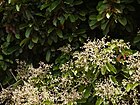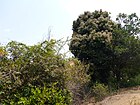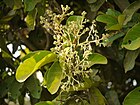Note: This is a project under development. The articles on this wiki are just being initiated and broadly incomplete. You can Help creating new pages.
Difference between revisions of "Vateria indica - Ajakarna, Piney"
(→Commonly seen growing in areas) |
|||
| Line 57: | Line 57: | ||
==Commonly seen growing in areas== | ==Commonly seen growing in areas== | ||
| − | {{Commonly seen| | + | {{Commonly seen|West coastal evergreen forests of India}}, {{Commonly seen|Secondary evergreen forest}}. |
==Photo Gallery== | ==Photo Gallery== | ||
Revision as of 16:53, 19 December 2018
Vateria indica is a species of plant in the Dipterocarpaceae family. It is endemic to India. It is threatened by habitat loss. This tree grows like a palm but has blunt thorns along its trunk.
Contents
- 1 Uses
- 2 Parts Used
- 3 Chemical Composition
- 4 Common names
- 5 Properties
- 6 Habit
- 7 Identification
- 8 List of Ayurvedic medicine in which the herb is used
- 9 Where to get the saplings
- 10 Mode of Propagation
- 11 How to plant/cultivate
- 12 Commonly seen growing in areas
- 13 Photo Gallery
- 14 References
- 15 External Links
Uses
Bloaitng, Abdominal pain, Gout, Neck stiffness, Skin eruptions, Locked jaw paralysis, Pimples, Diarrhea, Sore throats
Parts Used
Chemical Composition
Bark contains Dl-epicatechin, fischinidol and afzetechin. Tree yields a resin which is a complex mixture of triterpenes. Seeds yield semi solid fat known as Piney tallow or Malabar tallow. Fruit shell yields tannins. Gum yields lipids.[1]
Common names
| Language | Common name |
|---|---|
| Kannada | Damar |
| Hindi | Badasal |
| Malayalam | Baine, Kunturukkam |
| Tamil | Dhupa maram |
| Telugu | |
| Marathi | NA |
| Gujarathi | NA |
| Punjabi | NA |
| Kashmiri | NA |
| Sanskrit | |
| English | White Damar, Indian Copal |
Properties
Reference: Dravya - Substance, Rasa - Taste, Guna - Qualities, Veerya - Potency, Vipaka - Post-digesion effect, Karma - Pharmacological activity, Prabhava - Therepeutics.
Dravya
Rasa
Tikta (Bitter), Kashaya (Astringent)
Guna
Snigda (unctuous)
Veerya
Sheeta (cold)
Vipaka
Katu (Pungent)
Karma
Kapha, Vata
Prabhava
Habit
Identification
Leaf
| Kind | Shape | Feature |
|---|---|---|
| Simple | alternate | Leaves are spiral; stipules caducous; petiole 2-3.5 cm, swollen at apex, nearly glabrous |
Flower
| Type | Size | Color and composition | Stamen | More information |
|---|---|---|---|---|
| Unisexual | 2-4cm long | white | 5-20 | Inflorescence axillary panicles with dense stellate hairs |
Fruit
| Type | Size | Mass | Appearance | Seeds | More information |
|---|---|---|---|---|---|
| Capsule | 6.4 x 3.8 cm | 3-valved, calyx persistent, reflexed | With hooked hairs | - | {{{6}}} |
Other features
List of Ayurvedic medicine in which the herb is used
- Vishatinduka Taila as root juice extract
Where to get the saplings
Mode of Propagation
How to plant/cultivate
A tree of low to moderate elevations in the moist, monsoonal tropics, where it can be found at elevations up to 1,200 metres[3]
Commonly seen growing in areas
West coastal evergreen forests of India, Secondary evergreen forest.
Photo Gallery
References
External Links
- Ayurvedic Herbs known to be helpful to treat Bloaitng
- Ayurvedic Herbs known to be helpful to treat Abdominal pain
- Ayurvedic Herbs known to be helpful to treat Gout
- Ayurvedic Herbs known to be helpful to treat Neck stiffness
- Ayurvedic Herbs known to be helpful to treat Skin eruptions
- Ayurvedic Herbs known to be helpful to treat Locked jaw paralysis
- Ayurvedic Herbs known to be helpful to treat Pimples
- Ayurvedic Herbs known to be helpful to treat Diarrhea
- Ayurvedic Herbs known to be helpful to treat Sore throats
- Herbs with Seeds used in medicine
- Herbs with Bark used in medicine
- Herbs with common name in Kannada
- Herbs with common name in Hindi
- Herbs with common name in Malayalam
- Herbs with common name in Tamil
- Herbs with common name in English
- Habit - Herb
- Index of Plants which can be propagated by Seeds
- Index of Plants which can be propagated by Cuttings
- Herbs that are commonly seen in the region of West coastal evergreen forests of India
- Herbs that are commonly seen in the region of Secondary evergreen forest
- Herbs






